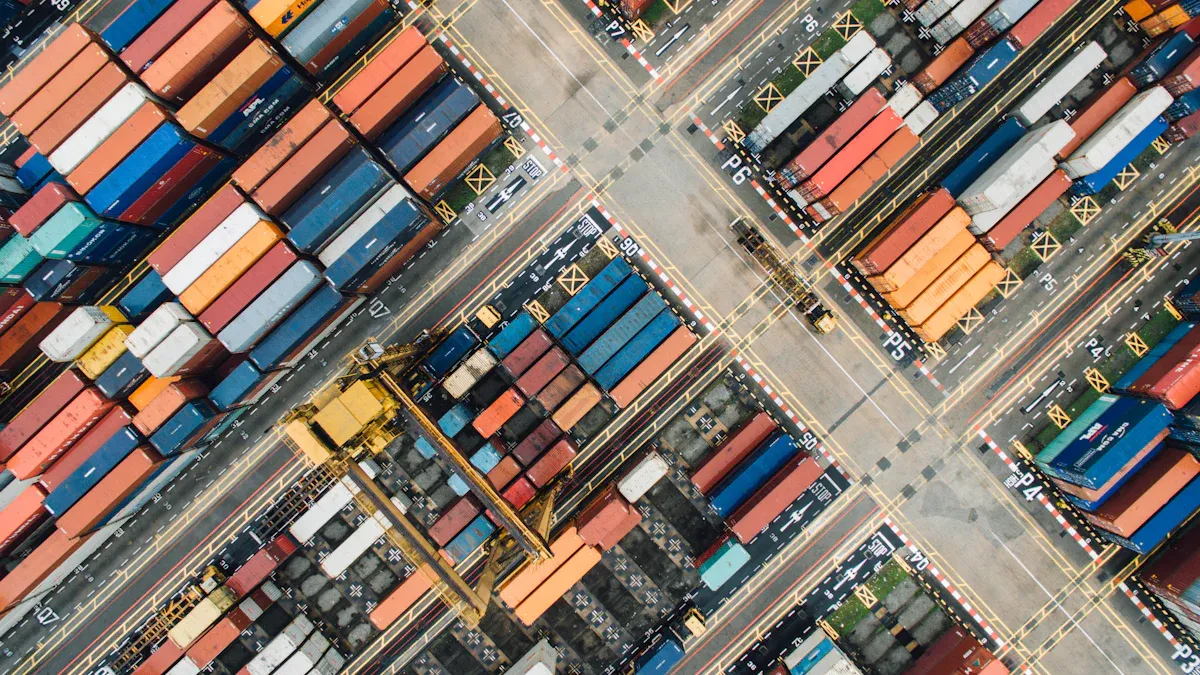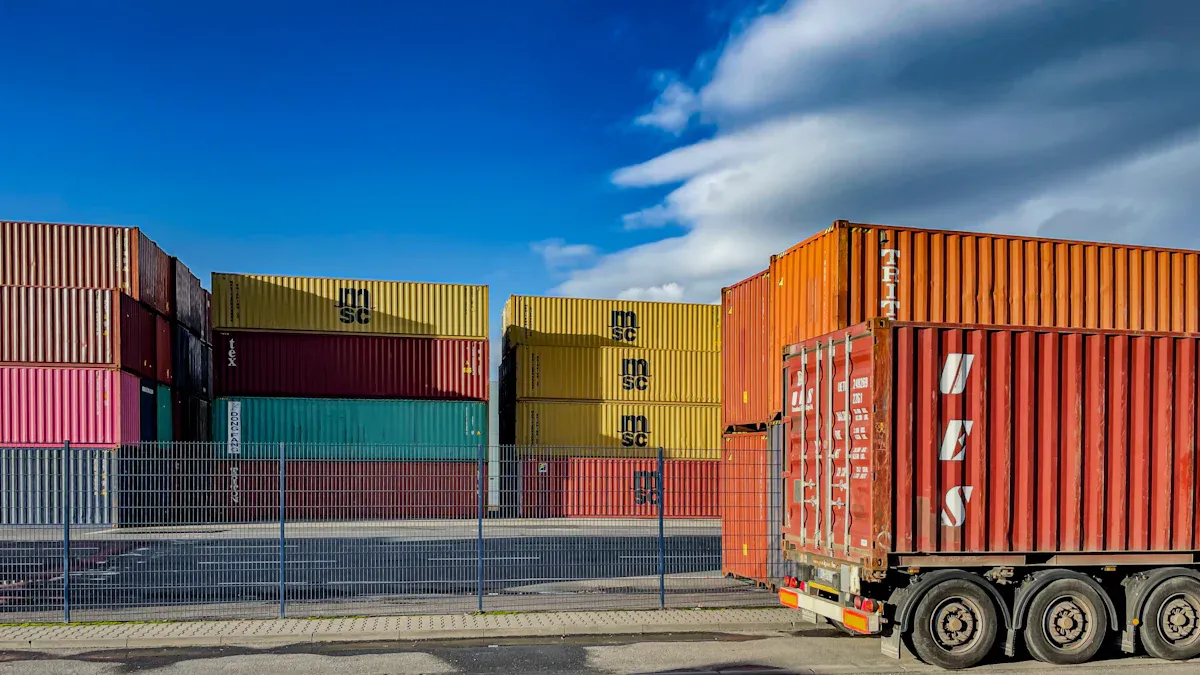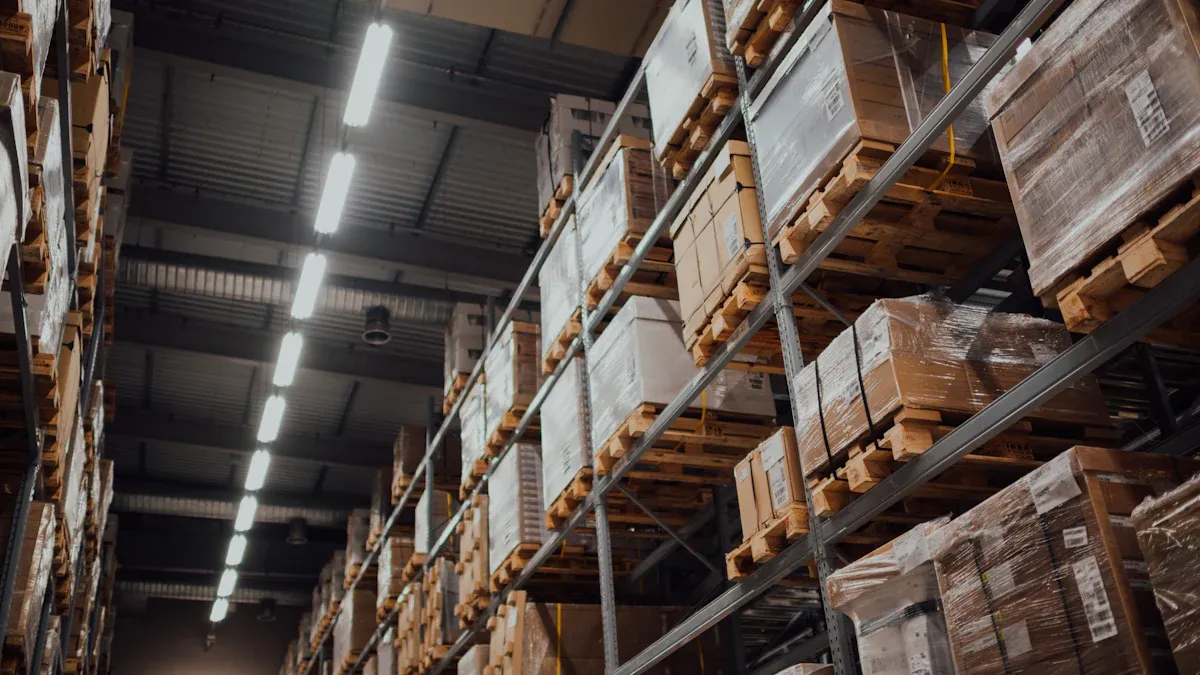Understanding the Difference Between Upstream and Downstream Logistics Frameworks

You encounter upstream and downstream logistics frameworks in every supply chain. Upstream logistics manages the flow of materials, focusing on procurement and production. Downstream logistics handles the movement of products and information to customers. Understanding this difference helps you boost supply chain efficiency. Recent studies show that knowing how each framework works lets you improve production schedules and meet customer needs faster.
Ask yourself: Do you know which parts of your supply chain belong to upstream or downstream logistics?
Key Takeaways
Upstream logistics focuses on sourcing raw materials and managing supplier relationships to ensure smooth production.
Downstream logistics centers on delivering finished products to customers, emphasizing order fulfillment and customer satisfaction.
Understanding the differences between upstream and downstream logistics helps improve supply chain efficiency and set clear business goals.
Investing in technology and automation can enhance both upstream and downstream logistics, leading to better visibility and faster responses.
Regularly review and analyze your logistics processes to identify opportunities for improvement and adapt to changing market conditions.
Upstream and Downstream Logistics Frameworks Overview

Upstream Logistics Defined
You start with upstream logistics when you manage the supply side of your business. This part of the supply chain focuses on getting raw materials, building relationships with suppliers, and planning production. You make sure materials move toward your manufacturing site. Your main goals include cost efficiency, reliable suppliers, and smooth production schedules.
You see new trends shaping upstream logistics every year. Companies now use automation and robotics to speed up fulfillment. Many businesses join digital freight marketplaces to connect shippers and carriers. You notice more AI-powered freight operations, which help you make smarter decisions. Supply chain agility matters more than ever. You need real-time data to track shipments and improve transparency. Sustainability also becomes a key part of your logistics strategy.
Latest Trends in Upstream Logistics:
Supply Chain Agility
Global Labor Shortages
Automation Complexity
Demands for Real-Time Data
Supply Chain Transparency for Critical Collaborations
Digital Freight Marketplaces
Ecosystem Integration Implementation
Tip: You can boost your upstream logistics by investing in automation and using real-time tracking tools.
Downstream Logistics Defined
You handle downstream logistics when you deliver finished products to your customers. This part of the supply chain starts after manufacturing. You work with distributors, retailers, and end users. Your job is to move products, money, and information through a complex network.
You focus on customer satisfaction and order fulfillment. You want your products to reach customers quickly and safely. You also manage brand reputation by making sure every delivery meets expectations.
Key Segments in Downstream Logistics:
Distributors
Retailers
Customers
You see that the flow of materials usually moves toward the customer. Money flows downstream, while information travels in both directions. You must keep track of orders and respond to customer feedback.
Why the Distinction Matters
You need to understand the difference between upstream and downstream logistics frameworks to manage your supply chain well. Each framework has its own focus, flow, and business goals.
You see that upstream logistics deals with suppliers and raw materials. Downstream logistics connects you with customers and finished products. You use different strategies for each part.
Here is a table that shows the main differences:
Aspect | Upstream Logistics | Downstream Logistics |
|---|---|---|
Primary Focus | Managing raw materials and supplier relationships | Delivering finished products and meeting customer demand |
Flow of Goods | Materials move toward the manufacturer | Finished products move toward the consumer |
Business Objectives | Cost efficiency, supplier reliability, and production planning | Customer satisfaction, order fulfillment, and brand reputation |
You improve your supply chain performance when you recognize these differences. You set clear goals for each framework. You choose the right tools and partners for upstream and downstream logistics frameworks.
Recent studies show that companies succeed when they treat each framework as a separate part of their strategy. You see better results when you match your logistics requirements to your business objectives.
Core Activities and Roles

Upstream Logistics Activities
You manage upstream logistics by focusing on the flow of materials before production begins. Your main activities include sourcing raw materials, negotiating with suppliers, and planning how goods move into your facility. You work with procurement teams to find reliable suppliers and set up contracts. You also track shipments and make sure materials arrive on time. You use technology to monitor inventory levels and improve efficiency.
Here is a table showing the key participants and their primary objectives in upstream logistics:
Key Participants | Primary Objectives |
|---|---|
Suppliers | Sourcing raw materials |
Procurement Teams | Managing supplier relationships |
Logistics Managers | Ensuring efficient inbound logistics |
You see that suppliers help you get the right materials. Procurement teams build strong relationships and negotiate deals. Logistics managers make sure everything moves smoothly into your warehouse.
Downstream Logistics Activities
You handle downstream logistics after products leave the factory. Your main activities include storing finished goods, managing orders, and delivering products to customers. You work with distributors and retailers to get products on shelves. You track shipments and respond to customer feedback. You focus on fast delivery and safe handling to keep customers happy.
The main stakeholders in downstream logistics include:
Distributors who move products to stores
Retailers who sell products to customers
Customers who receive and use the products
You notice that customer satisfaction depends on timely deliveries. Delays can lead to frustration and loss of trust. Customers may switch to other brands if they do not get their orders on time. Negative experiences can spread through word-of-mouth and reduce repeat business.
Key Participants and Objectives
You play a key role in both upstream and downstream logistics frameworks. In upstream logistics, you work with suppliers, procurement teams, and logistics managers. Your goal is to secure quality materials and keep production running smoothly. In downstream logistics, you collaborate with distributors, retailers, and customers. Your main objective is to deliver products quickly and maintain customer satisfaction.
You improve your supply chain by understanding the roles and activities in upstream and downstream logistics frameworks. You build strong relationships with suppliers and focus on efficient distribution. You keep customers happy by meeting their expectations and responding to feedback.
Comparing Upstream and Downstream Logistics Frameworks
Material and Information Flow
You see clear differences in how materials and information move through upstream and downstream logistics frameworks. In upstream logistics, you focus on getting raw materials and components from suppliers to your production site. You rely on demand forecasts and material requirements to guide your decisions. In downstream logistics, you move finished products from your factory to customers. You track sales data and listen to customer feedback to improve your service.
Here is a table that shows how these flows work in practice:
Aspect | Upstream Logistics | Downstream Logistics |
|---|---|---|
Focus | Procurement of raw materials and components | Delivery of finished products to customers |
Key Activities | Supplier management, procurement processes | Order fulfillment, distribution channel management |
Information Flow | Demand forecasting, material requirements | Sales data, customer feedback |
Material Flow | From suppliers to production | From production to customers, with returns possible |
Efficiency Goals | Cost savings, improved production efficiency | Reduced lead times, higher profit margins |
You notice that information travels both ways. In upstream logistics, you use forecasts to plan purchases. In downstream logistics, you use customer feedback to adjust your delivery methods.
Supply vs. Demand Focus
You manage supply and demand differently in upstream and downstream logistics frameworks. Upstream logistics centers on the supply side. You work to source materials at the best price and build strong relationships with suppliers. You plan your purchases to match your production schedule. You control inventory and watch costs closely. You prepare for risks like supply chain disruptions.
Downstream logistics focuses on the demand side. You respond to customer orders and make sure products arrive on time. You store inventory and manage distribution channels. You use real-time customer data to make decisions. You check product quality before delivery and align your marketing with inventory levels.
Here is a table that highlights these considerations:
Upstream Logistics Considerations | Downstream Logistics Considerations |
|---|---|
Procurement-centric: Focus on cost-effective sourcing of raw materials and parts. | Customer-centric: Emphasizes delivery times and service quality. |
Supplier relationship: Building strong, reliable supplier connections. | Logistics-driven: Relies on efficient inventory storage and distribution. |
Forecasting and planning: Aligning procurement with production schedules. | Demand-based decisions: Driven by real-time customer data. |
Inventory and cost control: Managing inventory levels and costs effectively. | Quality and consistency: Ensuring products meet quality standards upon delivery. |
Risk management: Preparing for potential disruptions in supply. | Marketing synergy: Aligning promotions with inventory and sales strategies. |
You see that supply-side management helps you keep production running smoothly. Demand-side management helps you satisfy customers and grow your business.
Business Goals and Challenges
You set different goals for upstream and downstream logistics frameworks. In upstream logistics, you want to optimize costs, secure high-quality materials, and reduce risks from supply chain disruptions. You focus on sourcing and production efficiency. You also look for ways to improve sustainability. Larger companies often use vertical integration to control their supply chains and boost environmental performance. You work with partners to design upstream activities that support sustainability.
In downstream logistics, you aim for customer satisfaction, fast delivery, and consistent product quality. You want every order to arrive on time and meet customer expectations. You use feedback to improve your service and build loyalty.
You face many challenges in both areas:
Supply chain disruptions can delay shipments and raise costs.
Rising fuel prices increase your operating expenses.
E-commerce growth means you must handle smaller shipments and offer faster delivery.
Labor shortages make it hard to find skilled workers.
Regulatory compliance takes time and resources.
Inventory management requires advanced systems to avoid overstocking or understocking.
Environmental concerns push you to adopt sustainable practices.
Tip: You can overcome these challenges by investing in technology, building strong relationships, and focusing on sustainability.
You improve your supply chain when you understand the practical differences between upstream and downstream logistics frameworks. You set clear goals, choose the right partners, and use data to guide your decisions.
Examples and Management Strategies
Real-World Examples
You can learn a lot from companies that have improved their supply chains. Many businesses use upstream logistics to get materials and manage suppliers. Here is a table showing how some companies succeed with upstream logistics:
Company | Strategy Description |
|---|---|
UPS | Adapted its logistics strategy to support healthcare during the pandemic, achieving significant turnover. |
XPO Logistics | Focused on long-term client relationships with adaptable solutions for changing market conditions. |
FedEx | Balances efficiency and flexibility in pricing to support outsourcing for clients. |
DHL | Outsourced logistics management to reduce overhead costs and tailored solutions for different industries. |
DSV | Invested in automation at a fulfillment factory to enhance logistics management across facilities. |
KLM Cargo | Implemented sustainable transportation models to reduce carbon footprint in air cargo operations. |
Downstream logistics also helps companies grow. You can see how these businesses solved problems and improved their results:
Company | Challenges | Solutions | Payoffs |
|---|---|---|---|
Faribault Foods | Needed end-to-end supply chain services | Improved processes and inventory planning | |
Snap-on Inc. | Poor material planning, high costs | Strategic sourcing and hub network | 4x earnings per share, $18M saved in transport |
Gold’n Plump | Needed direct store delivery | Best practice delivery model | Better margins and outbound efficiency |
Toro | Complex supply base, cost reduction needed | Streamlined processes and strategic sourcing | $162M savings, 5% profit improvement |
Lube-Tech | Growth outpaced capacity, poor data quality | Lean 6 Sigma tools and system integration | 4x revenue growth, 92% fewer late shipments |
Optimizing Each Framework
You can make your supply chain stronger by using proven strategies. For upstream logistics, focus on these areas:
Strategy | Description |
|---|---|
Use value-added services from transportation providers for better efficiency | |
Inventory Management | Find ways to reduce waste and improve storage and production |
Technology Integration | Use tech platforms for better visibility and control |
For downstream logistics, try these best practices:
System and process agility with automated operations
Build diverse supplier relationships for risk resiliency
Share data across systems for transparency
Optimize inventory with demand planning and reliable replenishment
Use socially responsible protocols for sustainability
Partner with third-party logistics providers (3PLs)
Foster collaboration and trust among partners
Integrate systems for a holistic view
Set clear rules to manage risks
Tip: You can combine technology and teamwork to boost both upstream and downstream logistics.
Leveraging Differences for Success
You can use the differences between upstream and downstream logistics to make your supply chain more resilient. Digital tools help upstream firms grow by focusing on customers. Downstream firms become stronger by working with more suppliers. Adjusting your customer and supplier mix helps you recover faster after disruptions.
When you integrate both frameworks, you gain many benefits:
Benefit | Description |
|---|---|
Streamline operations and remove waste | |
Customer Satisfaction | Improve customer experience with faster responses |
Cost Reduction | Save money by using resources wisely |
Increased Profitability | Boost profits through better performance |
Note: You can achieve better results by understanding and managing each part of your supply chain.
You see clear differences between upstream and downstream logistics. Upstream focuses on supplier management and material delivery. Downstream centers on order fulfillment and customer satisfaction. Use these steps to improve your supply chain:
Diversify your supplier base.
Use technology for better visibility.
Build strong communication with partners.
Review your logistics processes often. Data analysis helps you find new opportunities and make better decisions. For more learning, check this table:
Aspect | Description |
|---|---|
Upstream | Involves suppliers, raw materials, and inputs necessary for production. |
Downstream | Encompasses processes, distribution, and customer interactions post-production. |
Importance of Planning | Emphasizes the need for contingency plans to address supply shortages and demand spikes. |
Collaboration | Highlights the significance of sharing data and insights between upstream and downstream partners. |
FAQ
What is the main difference between upstream and downstream logistics?
You focus on suppliers and raw materials in upstream logistics. In downstream logistics, you deliver finished products to customers. Upstream supports production. Downstream ensures customer satisfaction.
Why should you separate upstream and downstream strategies?
You gain better control over your supply chain when you separate these strategies. This helps you set clear goals, choose the right partners, and improve efficiency in each area.
How does technology help in logistics management?
You use technology to track shipments, manage inventory, and share data. Tools like real-time tracking and automation make your supply chain faster and more reliable.
Who are the key players in upstream and downstream logistics?
In upstream logistics, you work with suppliers and procurement teams.
In downstream logistics, you connect with distributors, retailers, and customers.
Can you improve both frameworks at the same time?
Yes! You can use data analysis, build strong relationships, and invest in technology. These steps help you optimize both upstream and downstream logistics for better results.
See Also
Enhancing Global Efficiency Through Point-to-Point Logistics Systems
Key Strategies for Effective Global Logistics Management Success
Connecting Warehouses and Optimizing Supply Chains with PGL
Understanding East Coast B2B Warehousing and Distribution by PGL
Optimizing East Coast Import Warehousing and Delivery with PGL
